The iPad Air Review
by Anand Lal Shimpi on October 29, 2013 9:00 PM ESTGPU Performance
Since the iPad Air uses the same A7 silicon as the iPhone 5s, it also uses the same on-die GPU as the 5s: IMG’s PowerVR G6430. This is a 4-cluster configuration of IMG’s latest graphics hardware, running at some relatively high frequency. I already went into some detail on the G6430 in our 5s review so I won’t rehash that here, but we’re basically looking at a shift to a more efficient scalar architecture.
I still don’t have confirmations of clock speeds, but I believe we’re looking at a max GPU clock of around 450MHz. As you’ll see from the results below, there’s a small difference in performance between the iPad Air and iPhone 5s in terms of peak GPU performance - implying very similar clocks. The difference is the iPad Air should be able to sustain its max frequency longer than the iPhone 5s can.
| Mobile SoC GPU Comparison | ||||||||||||
| PowerVR SGX 554MP4 | PowerVR G6430 | PowerVR G6430 | ||||||||||
| Used In | iPad 4 | iPhone 5s | iPad Air | |||||||||
| SIMD Name | USSE2 | USC | USC | |||||||||
| # of SIMDs | 32 | 4 | 4 | |||||||||
| MADs per SIMD | 4 | 32 | 32 | |||||||||
| Total MADs | 128 | 128 | 128 | |||||||||
| GFLOPS @ 300MHz | 76.8 GFLOPS | 76.8 GFLOPS | 76.8 GFLOPS | |||||||||
| GFLOPS as Shipping | 68.1 GFLOPS (?) | 115.2 GFLOPS | 115.2 GFLOPS | |||||||||
Since we’re talking about an A7 here and not an X-series SoC, there’s still only a 64-bit wide memory interface. As memory bandwidth is a key enabler of GPU performance I was curious to see how GPU performance compared to the outgoing iPad 4 with its much wider memory interface. Do keep in mind that the A7 does include a large system cache on-die, which can help improve effective memory bandwidth.
GFXBench 2.7
We'll start our GPU performance analysis with a look at low level results using GFXBench/GLBenchmark 2.7. The low level tests, particularly the offscreen ones, should give us some idea as to whether or not there's any increase in GPU frequency for the iPad Air vs. iPhone 5s implementations of A7.
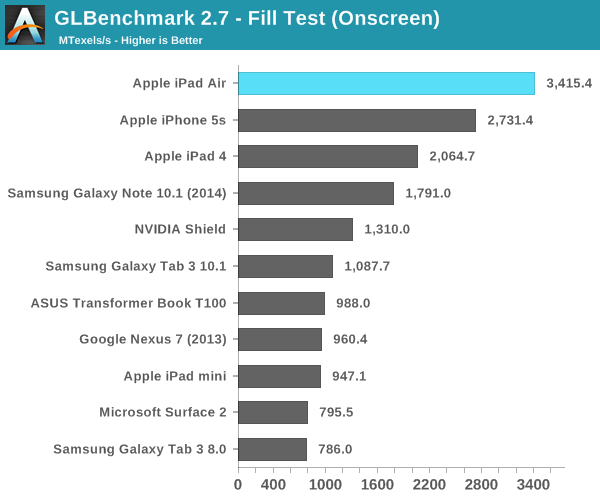
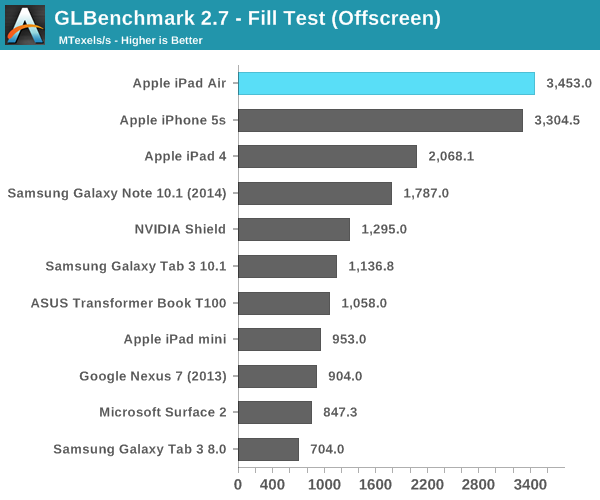
Looking at the fill rate results, there's a 4.5% increase in performance compared to the iPhone 5s. That could be the magnitude of clock increase that we're seeing between A7s. Apple could very well be relying on more thermal headroom in the iPad Air to provide any real world GPU performance advantages over the iPhone 5s.
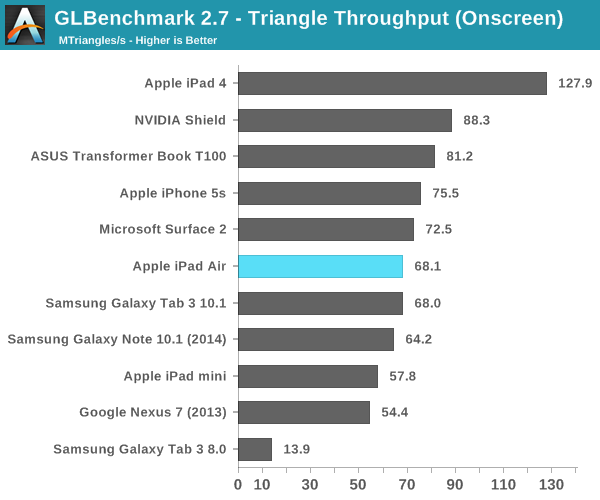

We see an even smaller gap between the Air and 5s in the triangle throughput tests (2.9%). There doesn't seem to be any substantial difference in GPU frequency between A7 implementations here. The regression in triangle rate performance compared to the iPad 4 is explained by differences in how Series 6 and Series 5XT GPUs scale in width. Whereas 5XT replicated nearly the entire GPU for "multi-core" versions, multi-cluster versions of Rogue only replicate at the shader array. The result? We don't see the same sort of peak triangle setup scaling we did back on multi-core 5XT parts. I'm not sure I'm particularly happy with the magnitude of the regression here, but I haven't seen any real world cases where it matters yet.
Next up are the game simulation tests. We'll start with the more strenuous of the two: T-Rex HD.
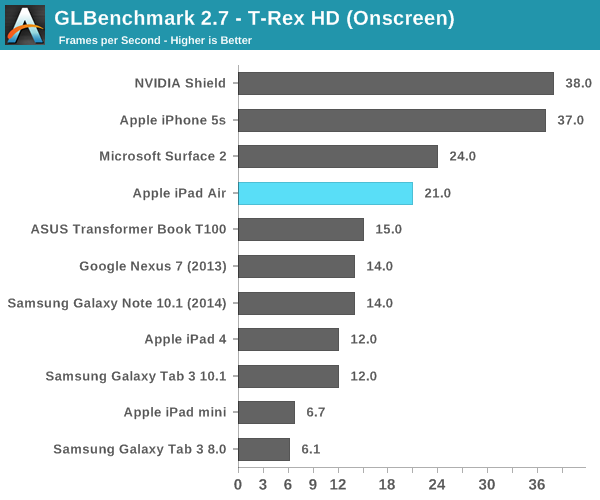
Here we get closer to Apple's claims of a 2x increase in performance. The iPad Air delivers 75% more performance than the iPad 4 in this test. Once again the iPhone 5s pulls ahead but that's because the onscreen tests render at display resolution, which is lower on the 5s.
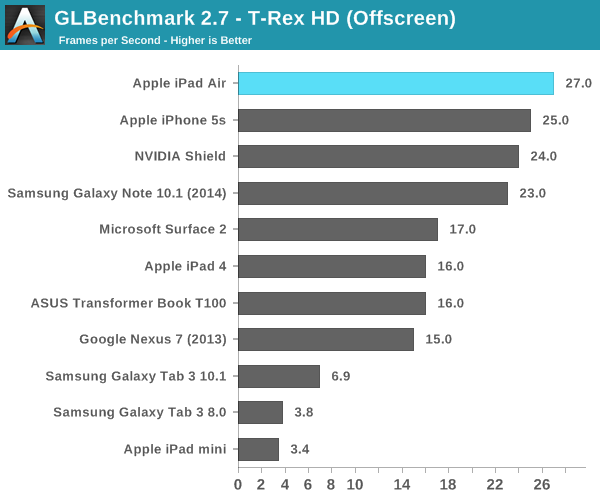
Offscreen performance sees similar scaling: ~69% better performance compared to the iPad 4.
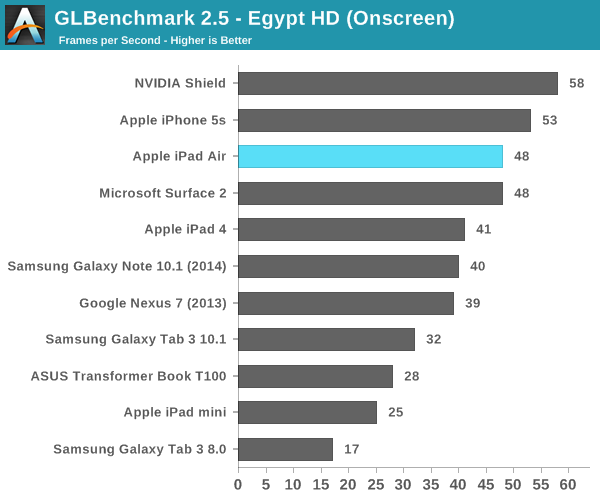
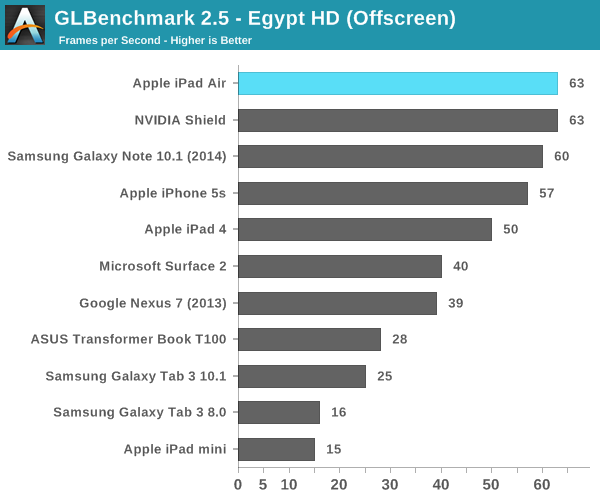
3DMark
We're once again running 3DMark's newest Unlimited mode which does its best to run independently of v-sync and at a standard resolution across all devices. I've also included 3DMark Extreme results below that feature a few more comparison points.
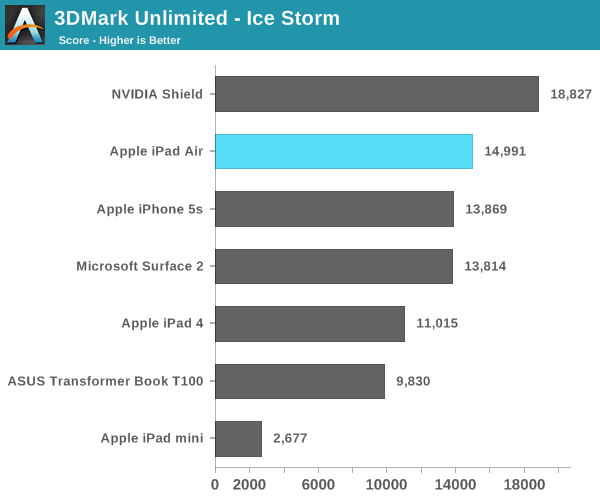
The overall Ice Storm scores show a 36% improvement in performance over the iPad 4 and an 8% increase compared to the iPhone 5s. Given the CPU frequency advantage of the A7 in the Air vs. the iPhone 5s, I'm guessing that's why we're seeing the performance gap we are here.
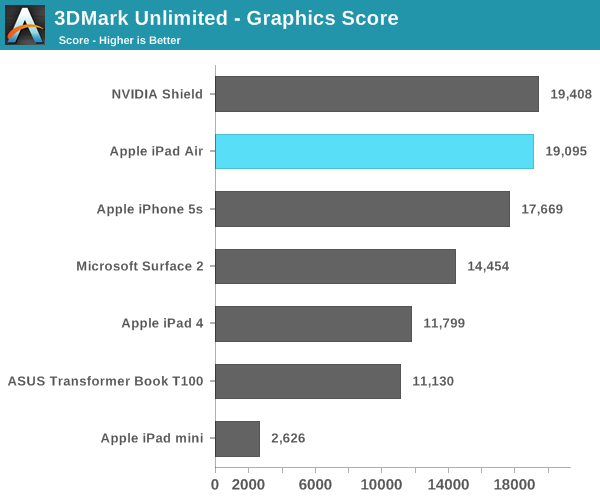
If we focus exclusively on the GPU tests (which themselves are still CPU bound), the iPad Air's performance advantage over the iPad 4 grows to over 60%.
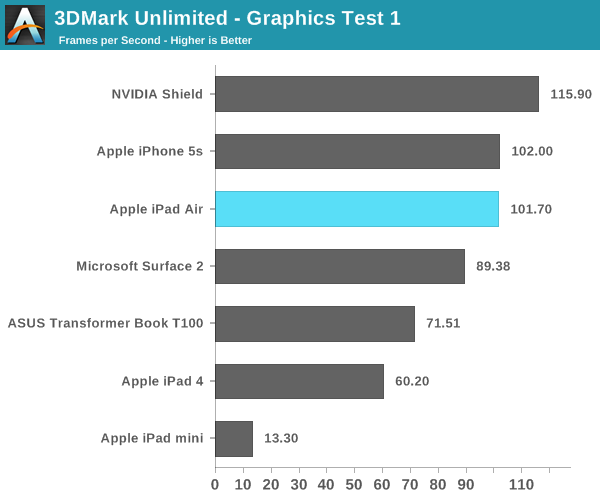
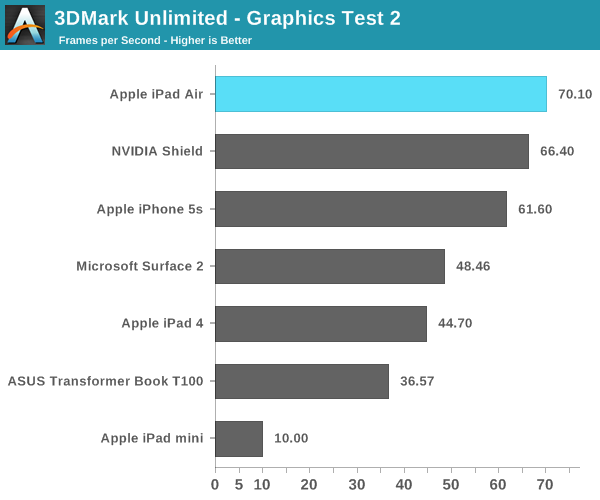
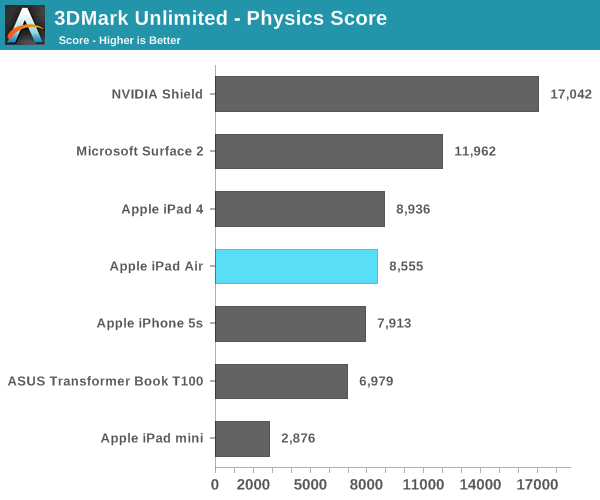
I'm still not entirely sure what's going on with the 3DMark Physics test, but we've seen this two reviews in a row now where Cyclone showed no performance increase at all compared to Swift despite this being largely a CPU test.
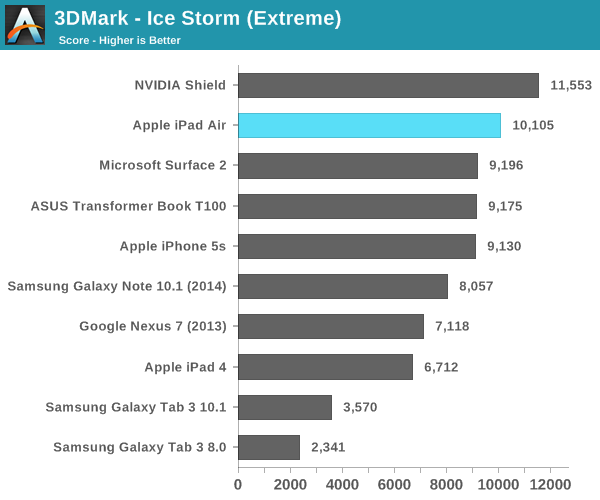
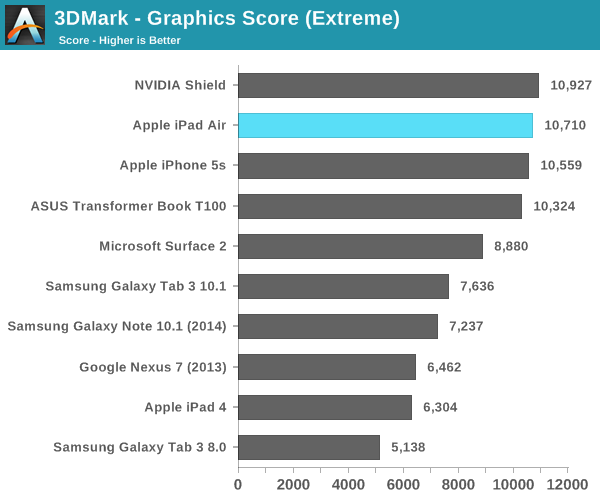
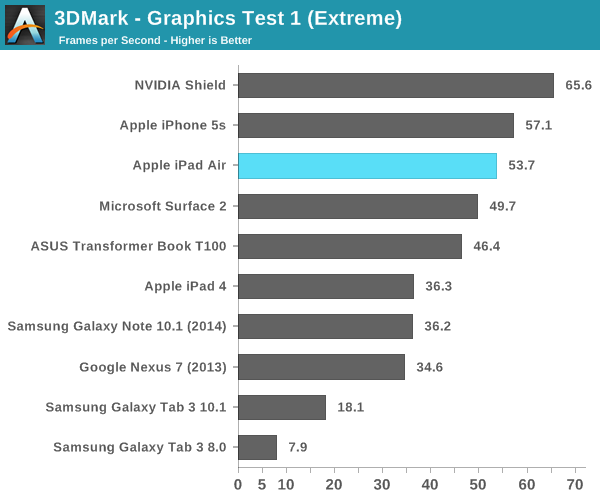
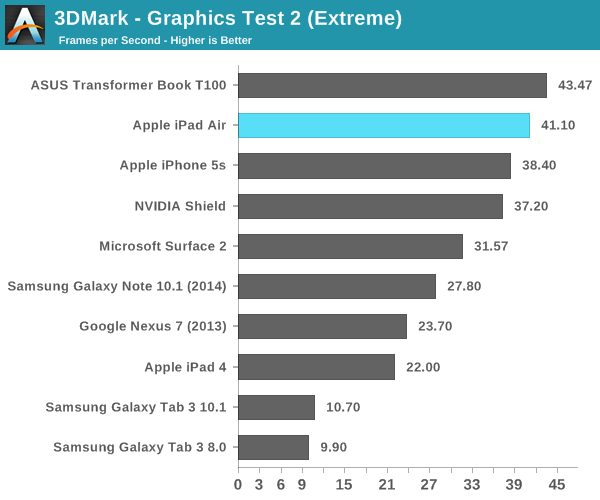

Basemark X
Basemark X is a new addition to our mobile GPU benchmark suite. There are no low level tests here, just some game simulation tests run at both onscreen (device resolution) and offscreen (1080p, no vsync) settings. The scene complexity is far closer to GLBenchmark 2.7 than the new 3DMark Ice Storm benchmark, so frame rates are pretty low.
I'm still having random issues with Basemark X reliably running both on and offscreen tests on iOS 7. Unfortunately I could only get onscreen results for the iPad Air, which came in at 46% faster than the iPad 4. Note the iPad mini and iPhone 5s benefit from having lower native resolutions here, which is why they perform so well.
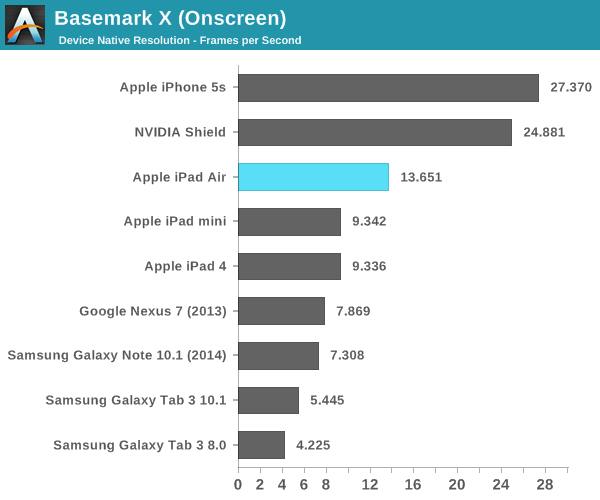










444 Comments
View All Comments
Krysto - Friday, November 1, 2013 - link
Why would the aspect ratio matter in calculating the surface area?thunng8 - Friday, November 1, 2013 - link
Of course aspect ratio affects areaTake an extreme example a tablet of length 25cm and width of 1cm. Surface area is 25cm^2. Diagonal is still 25cm. ( to be more precise 25.02cm).
gnx - Thursday, October 31, 2013 - link
As I mentioned, I find both a 7.9 inch ipad mini and galaxy note 8.0 (which is really closer to iPad Mini) both too cramped and small, as I use the table for foremost as a document reader on the go. And just to add, the Galaxy Tab 8.9 was 1280:800, thus 16:10, making even overall space closer to an iPad.Finally, for practically reasons, the Galaxy Tab 8.9 was nice, since because it's height in portrait mode was almost identical to an iPad 2/3/4, just narrower in breath, I could chose from most iPad accessories such as any carrying cases, pouches, bluetooth keyboard, etc.
yoshi1080 - Thursday, October 31, 2013 - link
I still love my iPad 3, but I'm thinking about upgrading. I do a lot of stuff on it and sometimes I wish it'd be faster. The iPad Air should be around 3–4x faster, right?Two of the most demanding tasks where I wish my iPad was faster are photo and video editing. I've already read that iMovie is supposed to be really fast on the iPad Air, so that's a clear advantage. My iPad's speed is sufficient for JPEG editing, but RAW processing (with PiRAWnha) is practically unusable. Processing RAW photos on my iPad would be my dream because photo editing on it is just so much more fun than on my iMac with the dreadfully slow Aperture – I'd be happy with getting 90% of the quality, but RAW is mandatory for me.
Up until now I thought the iPad Air would be much better suited for PiRAWnha. But now Anand writes about the RAM bottleneck due to the 64bit architecture and this makes me wonder: On the original iPad, the app often complained about too little available RAM and eventually crashed. I feel like the 1GB RAM on the iPad 3 is the reasonable minimum – would the Air be a disappointment in that regard? On the other hand, Adobe is working on bringing Lightroom and those smart DNGs to the iPad, and the beta version has even been shown running on an old iPad 2.
darkcrayon - Thursday, October 31, 2013 - link
Apps just don't need as much RAM as we think they do, especially mobile versions. Sometimes I'm surprised what can still run just fine on an iPad 2 (also helps of course that only one foreground app needs to run at a time). The Air should be 4 times faster than the iPad 3- should be no contest, especially in CPU.Death666Angel - Thursday, October 31, 2013 - link
Well, using one app at a time is fine, but browsing the web with a few tabs open and then switching to one or two other apps gets Apple device quickly ejecting stuff from RAM, where my Nexus devices are still having the pages loaded. :)fteoath64 - Thursday, October 31, 2013 - link
Thanks for the detailed review!. As I suspected the A7 behavior would have been rather different to wring out more performance out for the iPad as compared to the iphone. As you stated in the power consumption measurements, it seems the A7 is rather power hungry and only aggressive power management gets the battery life it needs. I am sure, it would be waiting for the TSMC 20nm process node as it seems this chip is just at the brink of 28nm as it is today. In making, the battery last so long without negatively impacting user performance, Apple has done a great job to achieve the balance using software. From the power draw alone, I figured out why it was clocked at such speeds instead of 1.6Ghz or 1.8Ghz. It cannot afford the power budget associated with it!.iwod - Thursday, October 31, 2013 - link
Sk Hynix Just announced a 6Gb LPDDR3. A Maximum of 3GB when 4 of them Stacked, Interesting isn't it?How about 2 Channel use? 1.5GB of Memory? May be a big company / customer would like / require this ?
While I hope Apple will give us 2GB in next generation. The reality may very well be we get 1.5GB of memory only.
bigup - Thursday, October 31, 2013 - link
is the 1GB RAM really a deal breaker? sold my ipad 3 to buy the iPad Air but now having seconds thoughts - what do you think?darkcrayon - Thursday, October 31, 2013 - link
It's not a deal breaker. You could argue in 2 years it would be better with more, but you're already the type of person that sells their less than 2 year old iPad for the latest, so... ;)